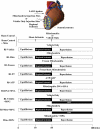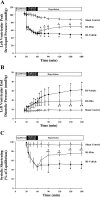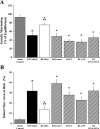Injection of isolated mitochondria during early reperfusion for cardioprotection
- PMID: 18978192
- PMCID: PMC2637784
- DOI: 10.1152/ajpheart.00567.2008
Injection of isolated mitochondria during early reperfusion for cardioprotection
Abstract
Previously, we demonstrated that ischemia induces mitochondrial damage and dysfunction that persist throughout reperfusion and impact negatively on postischemic functional recovery and cellular viability. We hypothesized that viable respiration-competent mitochondria, isolated from tissue unaffected by ischemia and then injected into the ischemic zone just before reperfusion, would enhance postischemic functional recovery and limit infarct size. New Zealand White rabbits (n = 52) were subjected to 30 min of equilibrium and 30 min of regional ischemia (RI) induced by snaring the left anterior descending coronary artery. At 29 min of RI, the RI zone was injected with vehicle (sham control and RI vehicle) or vehicle containing mitochondria (7.7 x 10(6) +/- 1.5 x 10(6)/ml) isolated from donor rabbit left ventricular tissue (RI-Mito). The snare was released at 30 min of RI, and the hearts were reperfused for 120 min. Our results show that left ventricular peak developed pressure and systolic shortening in RI-Mito hearts were significantly enhanced (P < 0.05 vs. RI-vehicle) to 75% and 83% of equilibrium value, respectively, at 120 min of reperfusion compared with 57% and 62%, respectively, in RI-vehicle hearts. Creatine kinase-MB, cardiac troponin I, and infarct size relative to area at risk were significantly decreased in RI-Mito compared with RI-vehicle hearts (P < 0.05). Confocal microscopy showed that injected mitochondria were present and viable after 120 min of reperfusion and were distributed from the epicardium to the subendocardium. These results demonstrate that viable respiration-competent mitochondria, isolated from tissue unaffected by ischemia and then injected into the ischemic zone just before reperfusion, significantly enhance postischemic functional recovery and cellular viability.
Figures











References
-
- Birch-Machin MA, Briggs HL, Saborido AA, Bindoff LA, Turnbull DM. An evaluation of the measurement of the activities of complex I–IV in the respiratory chain of human skeletal muscle mitochondria. Biochem Med Metab Biol 51: 35–42, 1994. - PubMed
-
- Bolling SF, Bies LE, Bove EL. Effect of ATP synthesis promoters on postischemic myocardial recovery. J Surg Res 49: 205–211, 1990. - PubMed
-
- Feinberg H, Levitsky S, Lee SL. The quiescent heart: excitability, compliance, and vascular resistance. Am J Physiol Heart Circ Physiol 251: H1085–H1089, 1986. - PubMed
Publication types
MeSH terms
Substances
Grants and funding
LinkOut - more resources
Full Text Sources
Other Literature Sources
Research Materials
Miscellaneous

